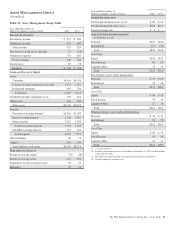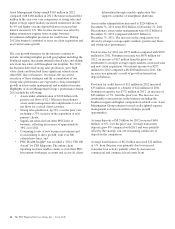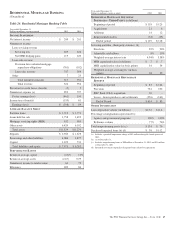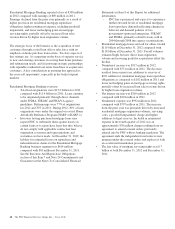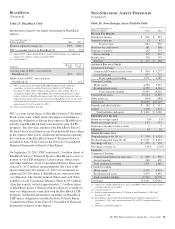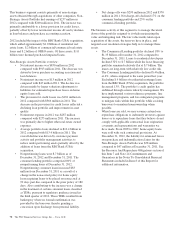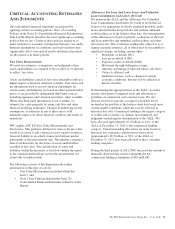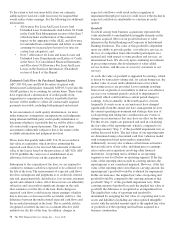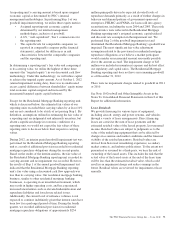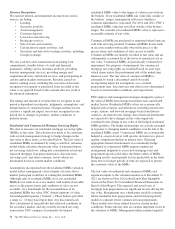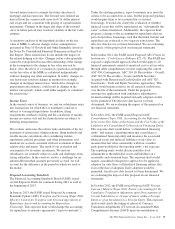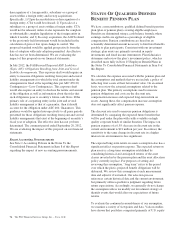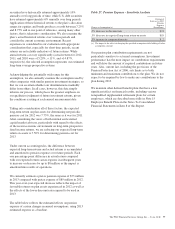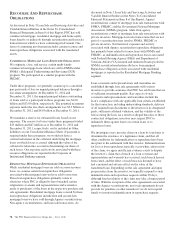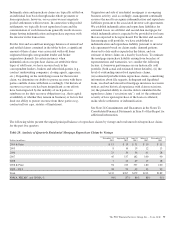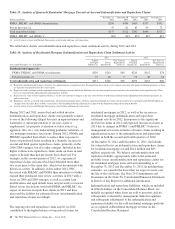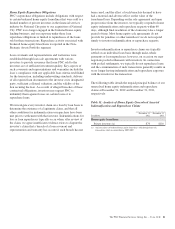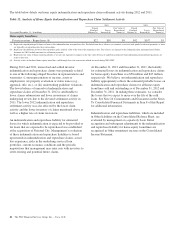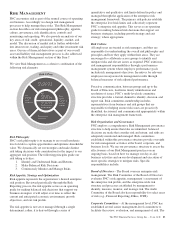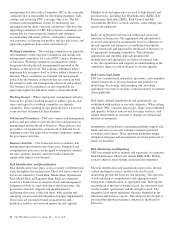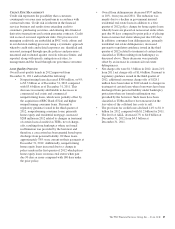PNC Bank 2012 Annual Report Download - page 94
Download and view the complete annual report
Please find page 94 of the 2012 PNC Bank annual report below. You can navigate through the pages in the report by either clicking on the pages listed below, or by using the keyword search tool below to find specific information within the annual report.forward interest rates to estimate the future direction of
mortgage and discount rates. The forward rates utilized are
derived from the current yield curve for U.S. dollar interest
rate swaps and are consistent with pricing of capital markets
instruments. Changes in the shape and slope of the forward
curve in future periods may result in volatility in the fair value
estimate.
A sensitivity analysis of the hypothetical effect on the fair
value of MSRs to adverse changes in key assumptions is
presented in Note 10 Goodwill and Other Intangible Assets in
the Notes To Consolidated Financial Statements in Item 8 of
this Report. These sensitivities do not include the impact of
the related hedging activities. Changes in fair value generally
cannot be extrapolated because the relationship of the change
in the assumption to the change in fair value may not be
linear. Also, the effect of a variation in a particular assumption
on the fair value of the MSRs is calculated independently
without changing any other assumption. In reality, changes in
one factor may result in changes in another (for example,
changes in mortgage interest rates, which drive changes in
prepayment rate estimates, could result in changes in the
interest rate spread), which could either magnify or counteract
the sensitivities.
Income Taxes
In the normal course of business, we and our subsidiaries enter
into transactions for which the tax treatment is unclear or
subject to varying interpretations. In addition, filing
requirements, methods of filing and the calculation of taxable
income in various state and local jurisdictions are subject to
differing interpretations.
We evaluate and assess the relative risks and merits of the tax
treatment of transactions, filing positions, filing methods and
taxable income calculations after considering statutes,
regulations, judicial precedent, and other information, and
maintain tax accruals consistent with our evaluation of these
relative risks and merits. The result of our evaluation and
assessment is by its nature an estimate. We and our
subsidiaries are routinely subject to audit and challenges from
taxing authorities. In the event we resolve a challenge for an
amount different than amounts previously accrued, we will
account for the difference in the period in which we resolve
the matter.
Proposed Accounting Standards
The Financial Accounting Standards Board (FASB) issued
several Exposure Drafts for comment during 2012 as well as
the beginning of 2013.
In January 2013, the FASB issued Proposed Accounting
Standards Update (ASU) Transfers and Servicing (Topic 860):
Effective Control for Transfers with Forward Agreements to
Repurchase Assets and Accounting for Repurchase
Financings. This exposure draft would change the accounting
for repurchase-to-maturity agreements (“repos-to-maturity”).
Under the existing guidance, repos-to-maturity may meet the
criteria to be accounted for as sales, but the proposed guidance
would require them to be accounted for as secured
borrowings. It would also clarify the evaluation of whether
financial assets that will be repurchased are “substantially the
same” as those transferred. Additionally, the exposure draft
proposes a change to the accounting for repurchases that are
part of repurchase financings, such that the initial transfer and
repurchase are evaluated as two separate transactions. The
effective date has not yet been determined. We are evaluating
the impact of this proposal on our financial statements.
In December 2012, the FASB issued Proposed ASU Financial
Instruments – Credit Losses (Subtopic 825-15). The FASB has
exposed a single-model approach which would apply to all
financial instruments carried at amortized cost or at fair-value
through other comprehensive income (replacing the current
ASC 450, Contingencies, ASC 310-10, Receivables – Overall,
ASC 310-30, Receivables – Loans and Debt Securities
Acquired with Deteriorated Credit Quality and ASC 320,
Investments –Debt and Equity Securities approaches). This
model would require reserves for all expected credit losses
over the life of the instrument. Under the proposal,
retrospective application with cumulative adjustment to
retained earnings will be required and early adoption would
not be permitted. The effective date has not yet been
determined. We are evaluating the impact of this proposal on
our financial statements.
In October 2012, the FASB issued Proposed ASU
Consolidation (Topic 810): Accounting for the Difference
between the Fair Value of the Assets and the Fair Value of the
Liabilities of a Consolidated Collateralized Financing Entity.
This exposure draft would define “collateralized financing
entity” and require a reporting entity that consolidates a
collateralized financing entity and measures the associated
financial assets and financial liabilities at fair value, to
measure that fair value consistently with how a market
participant would price the reporting entity’s net exposure.
The reporting entity would allocate portfolio-level
adjustments to the individual assets and liabilities on a
reasonable and consistent basis. The exposure draft would
require a modified retrospective approach to be applied at
adoption for only those collateralized financing entities that
exist at the date of adoption. Early adoption would be
permitted. An effective date has not yet been determined. We
are evaluating the impact of this proposal on our financial
statements.
In October 2012, the FASB issued Proposed ASU Foreign
Currency Matters (Topic 830): Parent’s Accounting for the
Cumulative Translation Adjustment upon Derecognition of
Certain Subsidiaries or Groups of Assets within a Foreign
Entity or of an Investment in a Foreign Entity. This exposure
draft would clarify the timing of release of Currency
Translation Adjustments (CTA) from Accumulated Other
Comprehensive Income (AOCI) upon deconsolidation or
The PNC Financial Services Group, Inc. – Form 10-K 75


